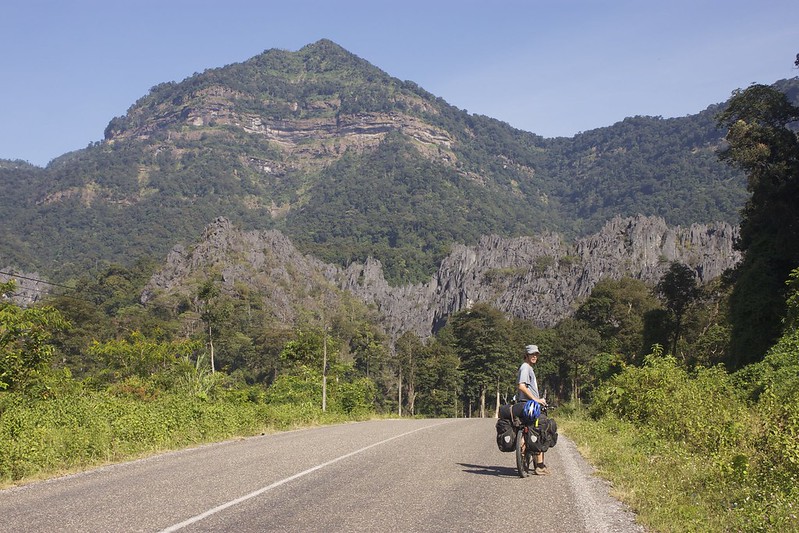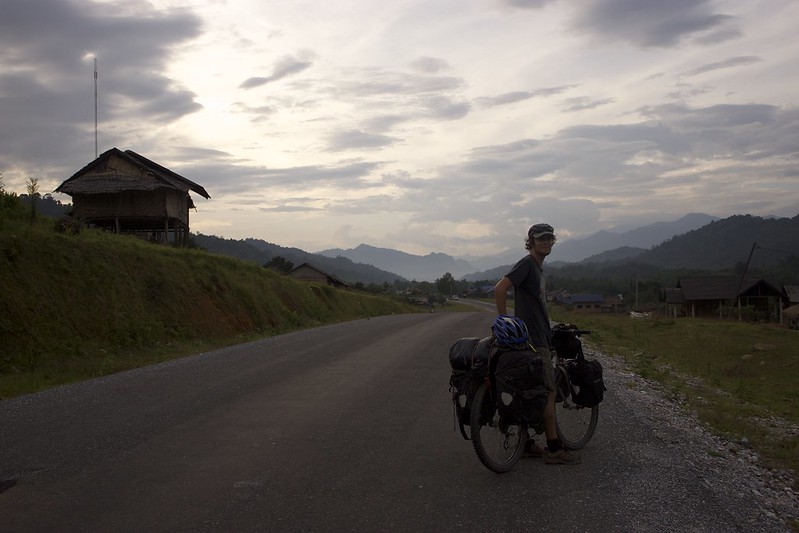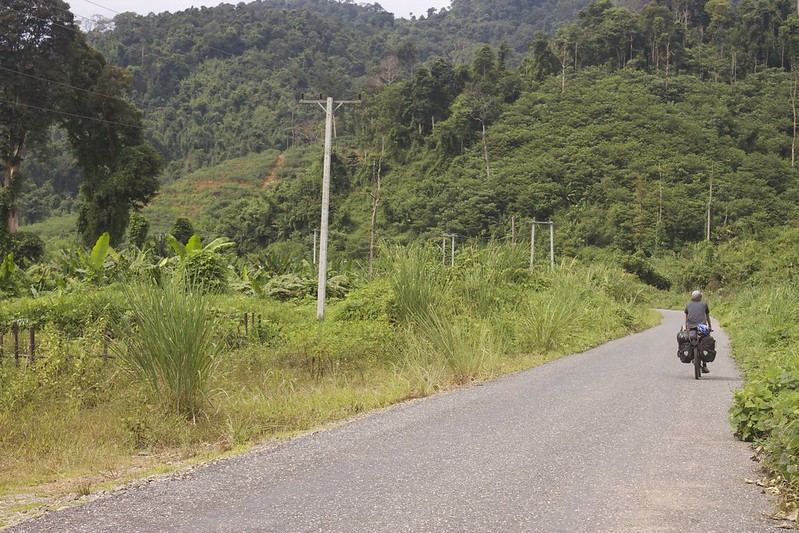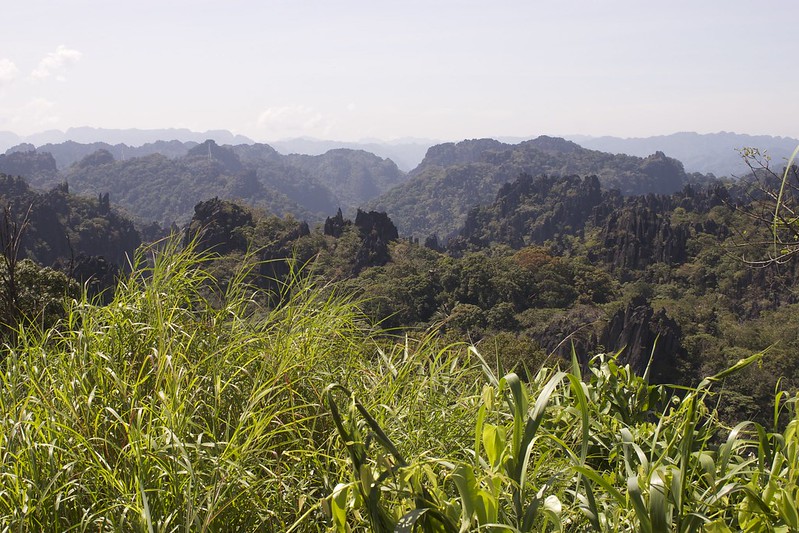Thursday 27 September, 2012. Somewhere near Muang Bo, Bolikhamsai, Laos.
The hills were darkening beneath a silvery sky when our pedalling was checked by barriers up ahead. A river cut right across our track and the unfinished bridge was barricaded off, hunks of concrete and rebar lying collapsed in the water below. We’d taken a gamble coming this way and it looked like we might have just lost. An entire day wasted. Our priority now was to find somewhere safe to sleep before nightfall, and wild camping was not an option. Something sinister lurked among these hills, ready to strike anyone who strayed from the road.
It all made the last few days seem rather pedestrian. Three days earlier we’d struck west out of Nahin, following the quiet highway as it wound over the folds of the land. Stacks of sedimentary rock towered around us as we heaved up the slopes, watching as we wheezed over the crests and disappeared away down the long stretches of descent the other side. From a hilltop vantage we saw a forest strewn with jagged castles of limestone, that were themselves invaded by shrubs and the spray-top canopy of dipterocarp trees, while down in the rambling countryside below, the glossy greens of the forest receded into lemoning grass and acres of twitching rice fields. Habitation was sporadic, but we’d previewed this route on the bus on our way to find a cash machine a couple of days earlier, so we could work our days around the few guesthouses we’d spotted along the way. Food came regularly enough, often noisy bowls of noodles slurped in the cool gloom of crooked roadside shacks.
On the second day we rejoined our old friend the River Mekong. We’d last seen her about a month ago when one of her tributaries blocked our way and got us thoroughly lost in eastern Cambodia. But we were still glad to see her. She slithered wide and smooth beside us, scoring out Laos’ upper-southern border with Thailand. For much of that second day we clung to her northern banks, until near the end of the afternoon when we arrived at the town with the ATM we’d visited on the bus all those days ago: a sparse, clay-coloured place called Paksan.
After finding a dank, mosquito-ridden guesthouse, we settled down to dinner at a restaurant on the crossroads at the edge of town. There was a tangible chill of apprehension that evening. The crossroads marked our departure from the highway and gateway into a web of backroads that spread out into the heart of the country. Craning round from our table, we could see the dusty brown road disappearing away into the dark. We had no idea what the road would be like up there, or how we’d manage with food and accommodation. Our map showed a number of small settlements, but these little white dots had varied recently from well-stocked villages like Nahin, to a single thatch hut or nothing at all. While food was a concern, it was accommodation that worried us. We had our tent, that was true, but we both agreed we would rather keep riding than risk beating a trail to pitch out here.
Back amid the helium-whine of the guesthouse that night, our little Laos history book filled us in on the details. During the Secret War of 1964-1973 the United States, in a bid to stem the encroaching tide of communism from North Vietnam, dropped more bombs on Laos than were dropped on Germany during the entirety of the Second World War. The equivalent of a plane dropping a cargo-load of bombs every eight minutes, twenty-four hours a day, every day, for nine years.
The weapon of choice was the cluster bomb. These devices start out as canoe-sized shells that tumble from the bellies of B-52s, then peel apart to scatter hundreds of apple-sized “bombies” like polystyrene balls in the wind. As they fall they whirl, priming them; and as they land they detonate, sending a ballistic spray of ball-bearings in all directions. The result is a flickering firewall that shudders through the jungle, shredding foliage, trees and anything else in its path.
The problem for Laos today is that up to 30% of these bombies didn’t whirl enough, didn’t prime—or did, but then didn’t explode when they thwacked into the dirt. The war ended and they remained, 80 million of them, and the land today remains infested.
They’re under the soil, in trees, in the rice fields, by the roads, in the playgrounds, even beneath the floors of houses and schools. They are an ever-present threat, killing or horrifically wounding hundreds of people—even now, forty years on—every year.
We were only inconvenienced in that we couldn’t go pitching a tent wherever we fancied—if there were no guesthouses this way, we could always ask to pitch in someone’s yard or behind a soup shack—but for the people of Laos there is no easy solution. Since the war ended, government organisations, local groups and international charities have worked tirelessly to clear a staggering 500,000 bombs from the country, and in doing so saved countless lives and enabled villages to expand and feed themselves in relative safety. But that still leaves 79.5 million to go.

The next morning we pedalled over the crossroads, off the little highway and away down the backroads. The road was narrower, but in good shape and much livelier than the highway, humming as it did with the day-to-day manoeuvrings of village life. Scooters buzzed by loaded with baskets, puppies and piglets trotted in the road, farmers stared from their seats on long-handled tractors, and kids squealed and scampered between the houses.
The further we rode the sparser the villages became, and by mid-afternoon we were alone on a narrow lane surrounded by tall grass and ferns. One by one the hills gathered and the climbing began. In the hot silence of the afternoon we found ourselves up against a roller coaster of brutal inclines, coils and plunges. These climbs were short, but they were very, very steep, and made worse by the rapidly deteriorating surface of the road. We had to stand and haul our whole bodyweight down onto the pedals to keep them turning, or else dismount and take a running charge. Here was a lick of the adventure we'd been after, and we spent most of the time wondering when on earth the road would flatten out again.
Thankfully it did ease off towards the end of the afternoon and we were rewarded with a beautiful evening ride, racing along a loping dusty trail with hill upon hill spread out before us, stacking back in gradated shades of smokey beryl into the pearl sunset.
As we came over another low rise we spotted the barriers, the river and the dead-end. The bridge was in pieces and completely impassable. Just as we were getting ready to turn back, a woman directed us down to the riverbank and we found a small crowd waiting for a motorised raft that was puttering over from the far side.
Ferried slowly over in the diminishing light, we were still anxious about finding somewhere safe to stay. We were lucky. In the next village, just as the sun touched the tip of the hills, the manager of a guesthouse overheard our enquiries and offered us a simple concrete room for the night. He handled the entire transaction with a straight-faced professionalism, showing us the room and cooly counting the money, perhaps hoping to distract from his unusually tender years. He was about twelve. The only time his age betrayed him was when he yelled at his parents to pass him the keys, and, stood waiting by the door, we felt like his mates getting permission to crash round for the night. We ate a noodle dinner and finally crawled into bed, the thrill at conquering the day quickly sinking beneath a deep and dreamless sleep.
* * * * *








Wonderful stuff - and love the photographs. The people of Laos have really suffered and are still suffering. We were there 8 years ago now but remember seeing people on crutches without limbs or horribly disfigured, obviously victims of the mines.
ReplyDelete